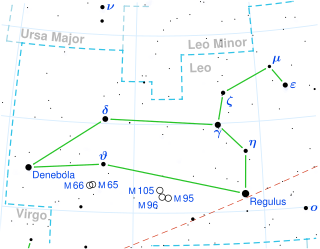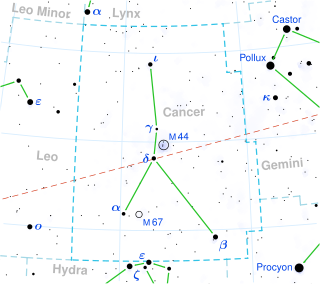
Equuleus is a faint constellation located just north of the celestial equator. Its name is Latin for "little horse", a foal. It was one of the 48 constellations listed by the 2nd century astronomer Ptolemy, and remains one of the 88 modern constellations. It is the second smallest of the modern constellations, spanning only 72 square degrees. It is also very faint, having no stars brighter than the fourth magnitude.

Atlas, designation 27 Tauri, is a triple star system in the constellation of Taurus. It is a member of the Pleiades, an open star cluster (M45). It is 431 light-years away, and is 3.92 degrees north of the ecliptic.

Gamma Leonis, also named Algieba, is a binary star system in the constellation of Leo. In 2009, a planetary companion around the primary was announced.

Alpha Piscium (α Piscium) is a binary star system in the equatorial constellation of Pisces. Based upon parallax measurements made by the Hipparcos spacecraft, it is about 151 light-years from the Solar System.

Alpha Vulpeculae, officially named Anser, is the brightest star in the constellation of Vulpecula. It is approximately 291 light-years from Earth. It forms a wide optical binary with 8 Vulpeculae.

Beta Cancri, also named Tarf, is the brightest star in the zodiacal constellation of Cancer. It has an apparent visual magnitude of +3.5 and an absolute magnitude of −1.2. Based on parallax measurements obtained during the Hipparcos mission, it is approximately 290 light-years distant from the Sun. An exoplanet, designated Beta Cancri b, is believed to be orbiting the star.

Gamma Capricorni or γ Capricorni, formally named Nashira, is a giant star in the constellation of Capricornus. Based on parallax measurements obtained during the Hipparcos mission, it is located at a distance of approximately 157 light-years from the Sun. The star is drifting closer with a radial velocity of −31 km/s. It is 2.56 degrees south of the ecliptic, so it can be occulted by the Moon, and (rarely) by planets.

Omicron Persei is a triple star system in the constellation of Perseus. From parallax measurements taken during the Hipparcos mission it is approximately 1,100 light-years from the Sun.

Mu Sagittarii is a multiple star system in the constellation of Sagittarius. The brightest component, designated Mu Sagittarii Aa, is formally named Polis. The system is 3,000 light-years from the Sun and is part of the Sgr OB1 stellar association.

Alcyone, designated η Tauri, is a star in the constellation of Taurus. Approximately 440 light-years from the Sun, it is the brightest star in the Pleiades open cluster, which is a young cluster, around 100 million years old. There are a number of fainter stars very close to Alcyone, some of which are members of the same cluster.

Zeta Tauri is a binary star in the zodiac constellation of Taurus, the Bull. It has an apparent visual magnitude of about 3.0, which is bright enough to be seen with the naked eye. Parallax measurements place it at a distance of roughly 440 light-years from the Sun.

Theta Tauri is a wide double star in the constellation of Taurus and a member of the Hyades open cluster.

Merope, designated 23 Tauri, is a star in the constellation of Taurus and a member of the Pleiades star cluster. It is approximately 440 light-years (135 pc) away.

Pleione is a binary star and the seventh-brightest star in the Pleiades star cluster. It has the variable star designation BU Tauri and the Flamsteed designation 28 Tauri. The star is located approximately 138 parsecs from the Sun, appearing in the constellation of Taurus. Pleione is located close on the sky to the brighter star Atlas, so is difficult for stargazers to distinguish with the naked eye despite being a fifth magnitude star.

46 Leonis Minoris, also named Praecipua, is the brightest star in the constellation of Leo Minor. It is of spectral class K0+III-IV and of magnitude 3.83. It is a red clump giant. Based upon parallax measurements, its distance from the Sun is approximately 95 light-years. It is a suspected variable with an amplitude of about 0.05 magnitudes.

Delta Velorum is a triple star system in the southern constellation of Vela, near the border with Carina, and is part of the False Cross. Based on parallax measurements, it is approximately 80.6 light-years from the Sun. It is one of the stars that at times lies near the south celestial pole due to precession.

Theta Aurigae is a binary star in the constellation of Auriga. Based upon parallax measurements, the distance to this system is about 166 light-years.

Sigma Librae is a binary star in the constellation of Libra. The apparent visual magnitude is +3.29, making it visible to the naked eye. Based upon parallax measurements, this system is at a distance of roughly 288 light-years from the Sun, with a 2% margin of error. At that distance, the visual magnitude is diminished by 0.20 ± 0.17 from extinction caused by intervening gas and dust.

Beta Cephei is a triple star system of the third magnitude in the constellation of Cepheus. Based on parallax measurements obtained during the Hipparcos mission, it is approximately 690 light-years distant from the Sun. It is the prototype of the Beta Cephei variable stars.

Tau Pegasi, formally named Salm, is a magnitude 4.6 star 162 light years away in the constellation of Pegasus. With about twice the mass of the Sun and thirty times as luminous, tt is a δ Scuti variable star with its brightness changing by a few hundredths of a magnitude over about an hour.

















